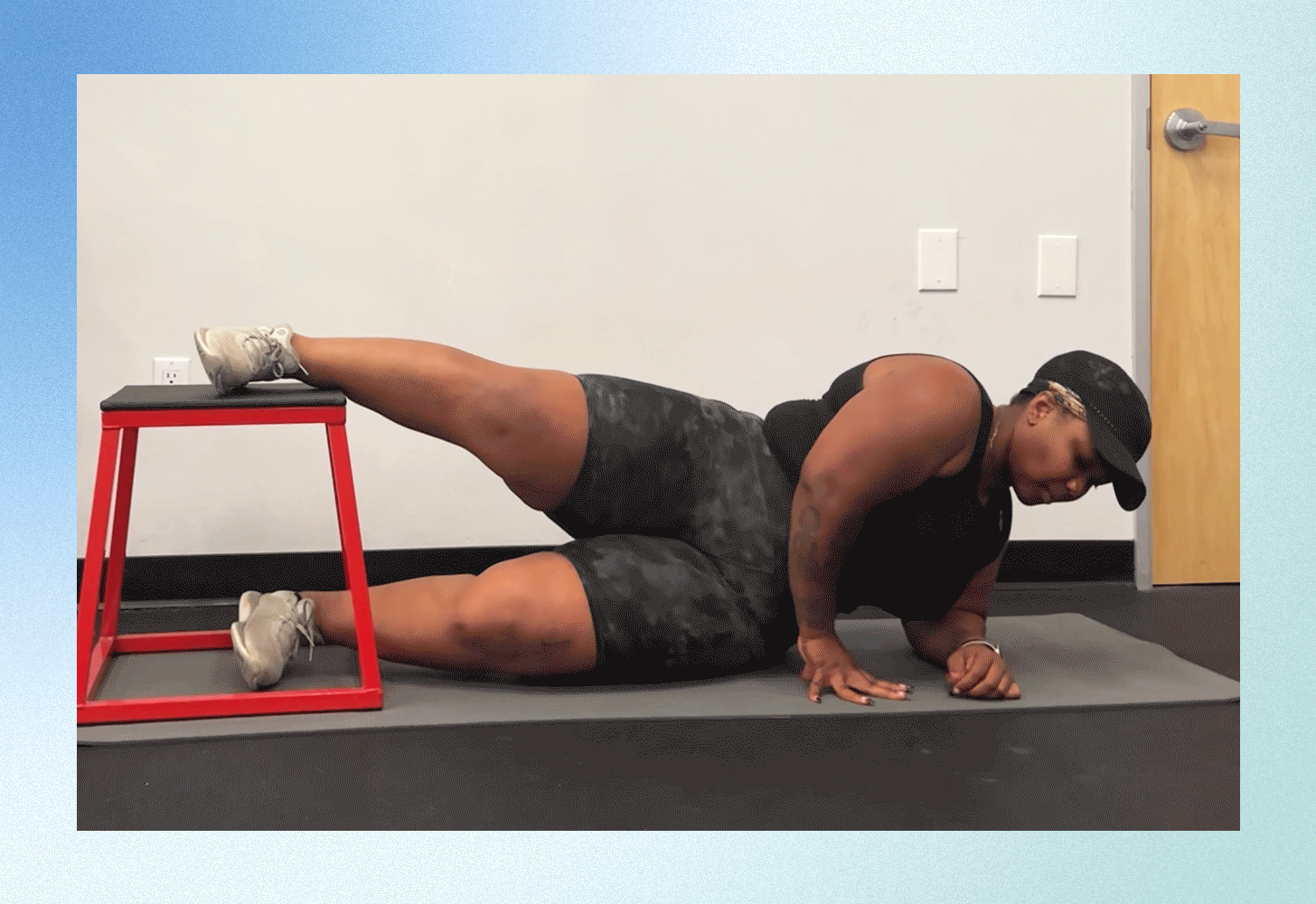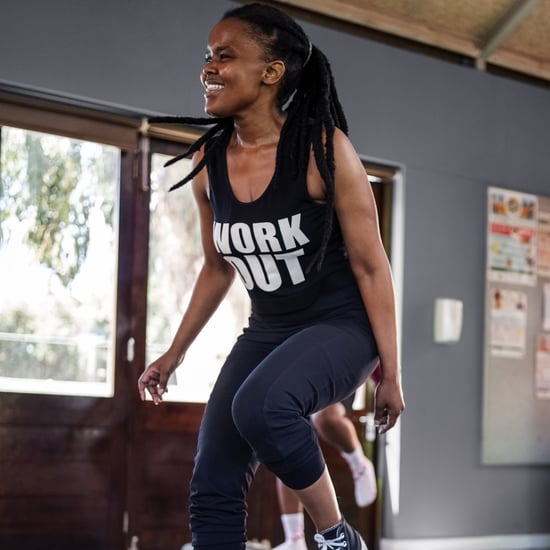What Is a Copenhagen Plank — and How Do You Do One?
Why the Copenhagen Plank Could Be the Missing Link in Your Leg Day

The plank is one of the most commonly performed core-strengthening exercises, and whether you're getting your heart-rate up at Barry's or at home (using a Class FitSugar video, per chance??), there's a good chance you've broken a sweat while doing traditional planks, side planks, reverse planks, and modified planks. Recently, an unfamiliar — and seriously spicy-looking — variation has been circulating on social media: with the Copenhagen plank or Copenhagen adduction exercise (CAE), you perform a side plank with your top leg resting on a bench; this way, your whole body hovers off the ground.
When I first came across Copenhagen planks on TikTok, I thought it was just another advanced side-plank variation; however, when I dug a little deeper, I found that most people were adding it to their workout routine specifically to increase their adductor, or inner thigh, strength. (And, while the actual origins of this exercise aren't known, the Danes are credited with the exercise because of the extensive research they've done on the topic of groin injuries and rehabilitation.) As fitness trainer Sharelle Grant, who demonstrated this exercise on TikTok, shared, "A lot of people under-train their adductors and it's a huge missing link in a lot of people's leg day."
People who have incorporated the Copenhagen plank into their workout routines have been keen to share the ways they've benefitted from the exercise. Physical therapist Stephanie Ridgway (Dr.Stephanie on TikTok) said that she's reduced her hip and knee pain. And bodybuilder Nsima Inyang posted a video saying, "In the past I'd pulled muscles in my groin from lifting and jiujitsu" — but that hasn't happened since he started training his adductors with exercises like Copenhagen planks.
This exercise can benefit everyone, according to strength coach and Alo Moves instructor Roxie Jones, but it is an advanced move. Even elite athletes may need to build up to it. Because of this, many physical therapists and trainers on TikTok have created progression videos for their followers to use in order to perform the move safely.
Keep reading to learn more about this trending move, including the benefits of the Copenhagen plank, how to properly get into the position, and a few variations to try.
Benefits of Copenhagen Planks
1. Strengthen and Balance Leg Muscles
Copenhagen planks increase strength in the abductors (outer thigh), hip flexors, and core, but its main target is the adductor muscles. Certified strength and conditioning specialist Ryan Nosak tells POPSUGAR that not many common exercises target the adductors, which means the muscle group doesn't often get the attention it needs. Weakness of the adductors can then cause strength imbalances in the legs that lead to injury.
NASM-certified trainer Cara Altieri says she incorporates CAE into both her personal training plan and the regimens of her clients as a preventative measure to reduce the chances of future injuries. "It helps strengthen the adductors and stabilise the hips, which helps with any aches and pains that come from a misaligned pelvic region or weak inner thighs," she explains.
Those who can benefit most from Copenhagen planks are people dealing "with sacroiliac issues, pelvic floor dysfunction, hip issues, and knee pain," according to Sara Robertson, a physical therapist assistant at Physical Therapy West in California. (Note: If you're dealing with any pain or injuries, it's best to consult a medical professional before trying to self-treat with exercises like this.)
2. Help Prevent and Rehab Groin Injuries
When people say they have a groin strain, what they most likely have is an adductor injury. Part of the groin, adductors are the group of muscles that run from the pelvic bone down through the inner thigh and into the knee. Because this area of the leg is so big, there are many different ways people can injure it, and Total Sports Medicine & Orthopedics reports that groin injuries make up 2 to 5 percent of all sports-related injuries.
Adductor injuries can happen in sports like football, where players experience sudden impact; football, where players are constantly starting and stopping; and distance running, where athletes repeat the same movement continuously, and which can cause an imbalance in the legs. (And let's be honest, they can also happen if you're — ahem — over a certain age and make any sudden movements.)
A 2018 study found that by incorporating Copenhagen planks into athletes' training programs, the prevalence and risk of groin problems in male football players were substantially reduced.
3. Improve Athletic Performance
The Copenhagen plank is an isometric exercise, where you hold one position without moving (e.g. a plank or wall sit). In general, "isometrics like the Copenhagen plank are great for muscle activation, teaching tension, and preventing injury," Jones says, because it teaches the muscles how to independently engage.
Whether you're a professional athlete or a parent playing at the park with your kid, strengthened adductors can improve your stability and agility. By increasing the strength, balance, and control in this region, you're creating a stronger base to jump higher, sprint faster, and move through various ranges of motions. In a practical sense, you'll be able to pivot and manoeuvre seamlessly in a netball game or sprint to your car in the rain. Additionally, you'll find it's easier to lift heavier or go lower in squats and deadlifts. Strengthened adductors can even improve your golf swing because you'll have more power as you rotate through the hips.
Even if you don't identify as an athlete, this kind of strength base matters: life is a constant obstacle course, and having the ability to move through your day with ease is the greatest benefit of all. "There are definitely a lot of technical ways to prescribe a Copenhagen plank to help with injury or chronic pain, but generally speaking, it's an amazing exercise for us all to practice and insert into our workouts," Altieri says.
How to Do Copenhagen Planks
Make sure you have a solid traditional side plank before you begin implementing the full variation of CAE. When you're ready, here's how to properly set up and perform a Copenhagen plank, according to Robertson.
- Start lying on one side with your forearm on the ground (left forearm if you're on your left side) and your shoulders stacked over your grounded elbow.
- Place your top calf on the bench and your bottom leg underneath the bench. Both legs should be straight and parallel to one another in this variation.
- Press into your calf that's on the bench and lift your hips to come in line with your shoulders. As your hips lift, be sure to keep shoulders stacked; you may have a tendency to rotate your top shoulder in as you lift up.
- Lift your bottom leg off the floor to bring it to meet the bench underneath. Hold this position.
- Continue to press into your forearm to stabilise your core as you utilise your adductor to lift your body.
- Slowly lower yourself back down onto the floor beneath you.
"There are variations to Copenhagen planks, so depending on what we're prescribing to the patient it could vary between 2-3 sets with 8-12 reps per set," Robertson says.
Altieri emphasises that you might need to work up to this fiery position. "It's not a beginner exercise," she says. "I usually start with my clients attempting 10-second holds and move up by 5 seconds or so from there."
If this exercise is new to you, you should start with isometric holds before you add movement to them.
Variations
Below are varying difficulty levels to this exercise starting from least difficult to most difficult.
You don't need a bench for this variation
- Start lying on your side with your forearm on the ground and your elbow under your shoulders; your bottom leg is on the floor at a 90-degree bend (thigh even with your hips) and your top leg is extended long.
- Lift your hips up and drive your bottom knee into your chest. Press the inside of your top leg into the floor and hold. This helps build strength in your top adductor so you can eventually progress to the full variation.
- Begin with your forearm on a bench or incline and set up as though you were preparing for a side plank.
- Once you find your side plank, draw you bottom knee up and into your chest as you keep your shoulders stacked over your elbow.
- You have the option to bring your top hand to your hip or extend it forward. This exercise is a great place to begin if you need to build strength and endurance for the full Copenhagen Plank.
Double Bent Knee Copenhagen Plank
- Begin on your side with your forearm down on the ground. Bend your top leg and place your knee on the bench.
- As you lift your hips, bend your bottom knee, and lift it up to meet the bench underneath.
- Continue to engage your core and press down through your forearm to stabilise the body. This is a great progression from the incline and floor variations as you work toward the full expression.
Foot-Supported Copenhagen Plank
- You will set up this modification the same way you would the full variation. However, instead of lifting your bottom leg up to the bench, you'll keep it on the floor.
- You still want this leg actively engaged just as you would in a traditional side plank and your aim is to keep your hips in line with your shoulders as you press your top leg into the bench. This exercise works the same muscle groups as a full expression of the exercise while lessening the body weight you're lifting to make it more accessible.
- Start lying on the ground in the same setup as your traditional Copenhagen plank with a weighted plate nearby.
- Once you lift your hips and bottom leg off the ground, bend your bottom knee into your chest and bring the plate to the inside of your bottom leg.
- Hold here and ensure your shoulders stay stacked and your knee remains at a 90-degree angle. This increases the intensity of the exercise and activates the psoas muscles of the bottom leg through hip flexion as well as its adductor as it holds the weight steady.






